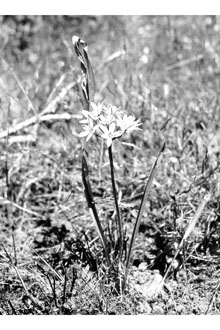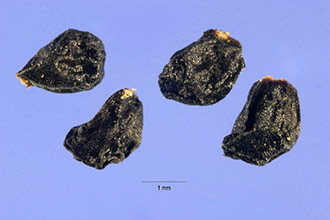Hesperoscordum hyacinthinum Lindl.
Scientific Name: Hesperoscordum hyacinthinum Lindl.

| General Information | |
|---|---|
| Usda Symbol | HEHY3 |
| Group | Monocot |
| Life Cycle | Perennial |
| Growth Habits | Forb/herb |
| Native Locations | HEHY3 |
Plant Guide
Alternate Names
White-flowered grassnut
Uses
Ethnobotanic: Corms were dug with a digging stick and eaten either raw, roasted, baked in an earth oven, or boiled by tribes in California including the Southern Maidu, Northern Maidu, Washoe, Pomo, Sierra Miwok, Atsugewi, and Northern Paiute.
Status
Please consult the PLANTS Web site and your State Department of Natural Resources for this plant’s current status, such as, state noxious status, and wetland indicator values, Use soil moisture sensors to measure the soil moisture of Hesperoscordum hyacinthinum Lindl..,
Description
General: Lily Family (Liliaceae). The white or bluish-white hyacinth-like flowers are in an umbel (in a head) of capitate clusters, each with 10 to 40 flowers. The flowers have green mid-veins. The basal leaves are linear and grasslike and wither with flowering. The scape is 3-6 dm tall. This perennial plant also vegetatively propagates from tan, fibrous-coated corms.
Distribution
For current distribution, please consult the Plant Profile page for this species on the PLANTS Web site. The plant is found in grasslands, close-cone pine forests, foothill woodland, and vernally wet meadows from zero to 2,000 m. The plant is found in the Central Valley, central western California, the Sierra Nevada, northwestern California, and the Cascade Range, up to Vancouver Island and east to Idaho. Alfred Brousseau © Brother Eric Vogel, St. Mary’s College @ CalPhotos
Establishment
If possible, obtain the seed and corms from local sources to maintain genetic diversity of white brodiaea and for the best adaptation to local conditions. Some nurseries may label their corms and seeds according to geographic source. If planting flowering-size corms, they can be directly planted outside. Plant the corms in the fall in full sun. The less crowded the more the corms will offset. Plant them 2 to 4 inches apart and 4 inches deep. A well-drained soil that is light and loose will produce bigger corms. Water and weed the patch regularly and protect it from small and large mammals, insects, and birds. Keep the ground slightly damp. If given too much water the corms will rot. If it rains fairly regularly, don't water the area. When the leaves on the plants have turned yellow and dried up, stop watering. Allow the corms to summer bake. The plants should be well established after one year. If planting seeds of white brodiaea, store the seeds in a paper bag until autumn. Plant the seeds before October 1st in a container and care for them for two years before planting them outside in the ground. Plant the seeds in six-inch (or bigger) pots because the corms will pull themselves down to the depth they require. Plant about 100 seeds per pot. Place them on top of the soil and sprinkle a little soil over them and put one-quarter inch gravel on top. Set the pots in partial shade so they won't dry out so fast. They can be outside or in a hot house. The seed does not need to be stratified. Start watering the pots right away and keep them slightly damp. Fertilize the pots in late winter and early spring and protect the plants from birds and other animals. If the pots are outside, let the rains naturally water the pots and in a drought year, supplement with hand watering. Stop watering as soon as the foliage of the plants turns yellow. Resume watering the next fall, if rains are insufficient. After the second year, separate the plants and transplant them two inches apart in the fall when the corms are dormant. Then water them. Grow them for one more year or two more years to bloom, repeating this cycle and then plant them outside in the ground in the autumn.
Management
The area of white brodiaea will require regular weeding and the use of a very weak solution of fertilizer twice only during the active growth in the spring. The corms can be kept from overcrowding by thinning them every three years. This involves picking off the cormlets and replanting them elsewhere in the garden. There are five major types of indigenous management activities conducted in California that were designed to ensure future corm production at traditional gathering sites: 1) conscious breaking off cormlets from the harvested parent corms and replanting them; 2) sparing whole plants; 3) harvesting the corms after plants have gone to seed and dumping the seeds on the ground; 4) burning areas; and 5) irrigation. Periodic digging and thinning of the corms, and popping off the cormlets and replanting them may enhance grass nut numbers and densities. Digging corms may in fact be a form of tillage, which will increase the size of the gathering tract, aerate the soil, lower weed competition, and prepare the seedbed to increase seed germination rates. If grass nut populations require periodic disturbance to maintain and increase their populations, then indigenous harvesting regimes if reenacted, may help maintain populations. Populations becoming overcrowded or showing reduced vigor should be thinned. Cultivars, Improved and Selected Materials (and area of origin) This species is not readily available from commercial nurseries. Contact your local Natural Resources Conservation Service (formerly Soil
Conservation
Service) office for more information. Look in the phone book under ”United States Government.” The Natural Resources Conservation Service will be listed under the subheading “Department of Agriculture.”

